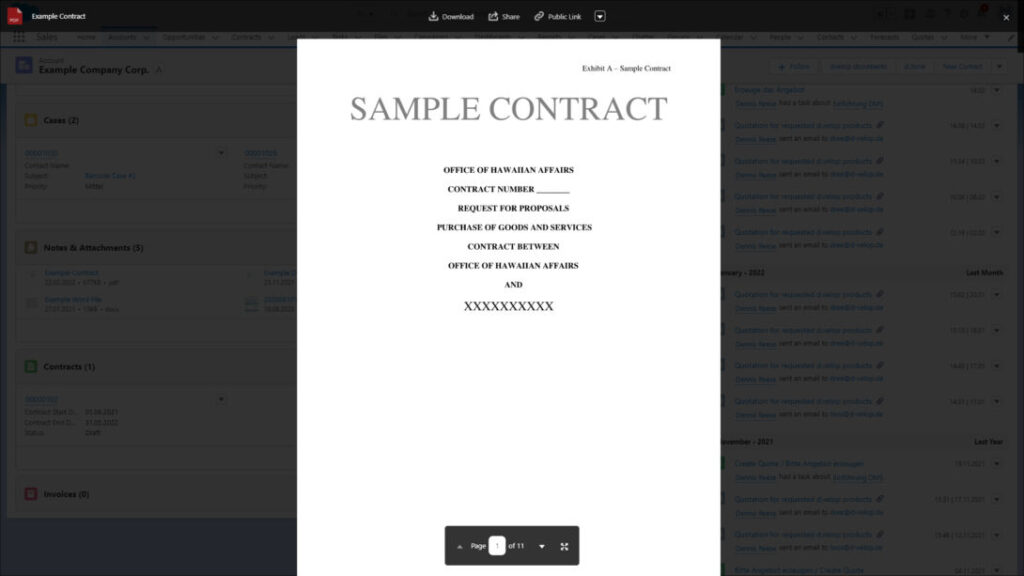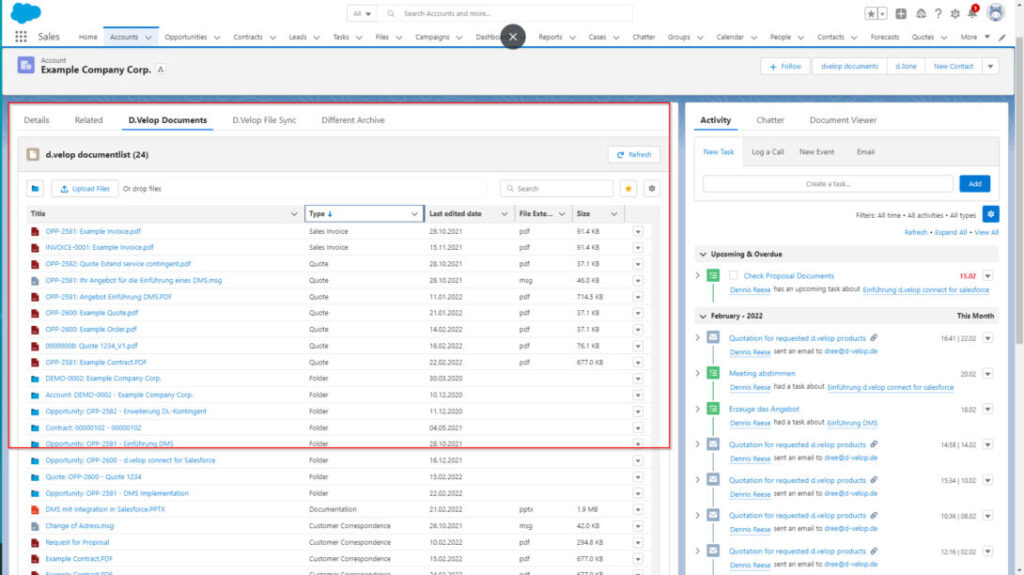Salesforce is often the leading system within companies and is used across various business areas. Whether in sales, service, or marketing – processes are mapped through Salesforce. However, the creation and management of related documents often take place within a fragmented IT landscape. As a result, documents are stored in different systems and are not centrally accessible to all employees. For business-critical processes to run effectively, all departments must have access to the relevant documents. Consequently, the standard scope of Salesforce collaboration is often insufficient. This blog article explores what the standard scope includes and why implementing a DMS can significantly enhance Salesforce collaboration.
What does Salesforce Collaboration actually mean?
Collaboration, in general, refers to “the joint effort of multiple individuals or workgroups to complete a task or carry out a project. These project teams can be separated both geographically and organisationally. For instance, some employees may be located at a different company site or in another department. External service providers can also be integrated in this way.”
In this context, Salesforce Collaboration refers to the collaboration capabilities that Salesforce enables within a company. As previously mentioned, these capabilities are rather limited in the standard version when it comes to enabling truly effective collaboration across the organisation.
Enabling Successful Salesforce Collaboration with an Integrated DMS
Providing all employees with access to documents is an important first step towards effective Salesforce collaboration. However, access alone is not enough – companies also need simple and reliable ways to initiate workflows and edit documents across systems. The standard features offered by Salesforce are often insufficient for these purposes, posing challenges when it comes to implementing seamless processes. A document management system (DMS) that is centrally accessible to all employees and offers interfaces to common CRM and ERP systems can significantly boost your company’s efficiency and success.
Let’s take a closer look at the collaboration features available in Salesforce and explore how integrating a DMS can enhance them – step by step!
Built-in Document Features in Salesforce
When exploring document management within Salesforce, it’s worth taking a closer look at the standard features already included in the platform that aim to support document handling and collaboration:
- Files Home: This area allows users to upload personal documents and share them with team members.
- Salesforce CRM-Content: Enables the creation and sharing of various documents based on templates. These documents can be shared both internally within the team and externally.
- Salesforce Knowledge: Used for sharing articles that support knowledge transfer. Articles can be categorised and made available both internally and externally.
- Documents Tab: A place to store visual assets such as logos (used in Visualforce pages).
- Attachments: This feature allows files to be attached to various data types (e.g. contracts or quotes).

Documents stored in the various categories can be enriched with additional metadata after upload to improve discoverability via global search. However, true DMS functionalities – such as full-text search or attribute-based search – are not available. Document-based workflows, such as approval processes for incoming invoices, also cannot be mapped directly in Salesforce. These can only be implemented with considerable effort using Process Builder or Flows as custom logic.
How can I manage files stored or created in Salesforce?
Once a document is stored in Salesforce, the options for further processing are unfortunately quite limited:
- Viewer: Displays a preview of the document. Advanced features such as zooming are not available.
- Download: Files can be downloaded.
- Share: Documents can be shared within the organisation.
- Public link: By generating a public link, external users can also access the documents.
- Upload new version: Users can upload a new version of the document.
- File details: Additional metadata can be added to the document here (title and description are standard fields).

How Are Documents Stored in Salesforce?
Storage is another important aspect within the Salesforce ecosystem. While each organisation and user is allocated a certain amount of included storage, costs can quickly rise once this quota is exceeded. To integrate additional storage outside of Salesforce, the platform offers Salesforce Files Connect. This allows cloud storage services such as OneDrive, Box, or Google Drive to be connected and used. However, this tool comes with several limitations: files can only be shared and pinned with colleagues via the Chatter function.
At first glance, the available features may seem extensive. However, they are not sufficient to enable true, company-wide collaboration on documents.
Benefits of a Document Management System for Salesforce
Having now examined the document features within Salesforce, a mixed picture emerges. Not all employees in a company will have a Salesforce account, meaning they have no way to work with documents within the platform. Due to the high licensing costs, providing access for everyone is often not a viable option. In addition, the high storage costs in the Salesforce cloud present another challenge, especially when dealing with large volumes of documents. A further complication is the fragmented system landscape: documents are often generated in other systems and are therefore not available within Salesforce. In such cases, implementing a document management system (DMS) like d.velop documents – combined with a comprehensive Salesforce integration – can help ensure that all customer-related documents are accessible to authorised employees. Beyond that, a DMS integrated into the Salesforce environment offers several additional advantages:
Clear (Digital) Folder Structure & Metadata-Based Search
When dealing with a high volume of documents, finding files and file-related information can become challenging. This is especially true when a document is relevant to multiple records, which can quickly lead to unnecessary duplicates. These not only consume additional storage space but also result in employees working with inconsistent information. By using a context-based search via metadata and a centralised digital folder structure, documents can be displayed in a structured way across different records – directly within Salesforce. As a result, every employee can access all relevant information at any time.
Advanced Search Functions
Salesforce’s global search only allows users to search by file name. This can be problematic when key details are unknown, making it difficult to locate the right file. For example, imagine you’re looking for a customer order but don’t have the order or transaction number – you only know the customer ordered a product called “DMS.” This is where the powerful search capabilities of a DMS come into play. Unlike Salesforce, a DMS searches not only by file name but also through metadata, attributes, and the full text of documents – thanks to integrated OCR (optical character recognition). This ensures that even with limited information, relevant documents can still be found.
Office Integration
Most modern document management systems now offer Office integration, allowing Office documents to be edited directly in the browser. With the right integration into the Salesforce environment, quotes, contracts, and similar documents can be edited and finalised directly from within Salesforce using familiar Office applications – and then shared with the customer using Salesforce’s built-in tools. This is another key feature on the path to successful Salesforce collaboration!
Digital Document Management Easy Explained
Key features, implementation steps, and AI insights – all in one practical guide.
Legal Compliance
Companies within the European Union face significant challenges when it comes to legally compliant data management. Whether it’s GoBD or GDPR, a document management system (DMS) as a central data repository enables businesses to store documents in a tamper-proof and traceable manner, ensuring full compliance with legal requirements. Additionally, data is stored within the EU – something that is not necessarily guaranteed when using Salesforce or other providers.
Always Access the Latest Version of a Document – Anytime, Anywhere
Decentralised data storage and limited access for some employees often lead to duplicates and outdated files. With d.velop documents, all employees can work on the same document – whether within Salesforce or directly in the DMS. Thanks to audit-proof versioning, all changes to documents are traceable, and previous versions can be restored if needed.
The Repository – Your Choice
Whether d.velop documents is used in the cloud, on-premises, or in a hybrid setup – the choice is yours. The system can be tailored to your organisation’s specific needs. Additionally, d.velop offers a Microsoft 365 adapter, allowing SharePoint to be used as a repository. Of course, even in this setup, documents remain accessible directly within Salesforce.
Is d.velop documents for Salesforce the Right Fit for Me?
First and foremost, it’s important to clarify what you want to achieve with a DMS for Salesforce. If the goal is simply to store existing files and documents elsewhere to reduce Salesforce storage costs, then external storage apps from various providers may be the most suitable and cost-effective solution.
Choosing the Right DMS for Optimal Salesforce Collaboration
However, if your aim is to organise documents properly, make them accessible across the entire organisation, and benefit from full DMS/ECM functionality, then it’s worth taking a closer look at d.velop documents for Salesforce. To help guide your decision, consider the following questions:
- Are there employees in your organisation who don’t have access to Salesforce but still need to view or store documents?
- Do you want access to all relevant customer documents, even if they weren’t created or stored in Salesforce?
- Do you need to comply with legal requirements when storing and processing documents?
- Do you want to extend Salesforce with true DMS capabilities?
- Do you want your employees to work more efficiently and effectively with Salesforce?
For some companies, Salesforce’s built-in document management tools may be sufficient. However, if your organisation is looking to get more out of its data, streamline cross-departmental collaboration, and ultimately deliver an outstanding customer experience – then it’s definitely worth taking a closer look at d.velop documents for Salesforce!
